THE VILLAGE TIMES
Independence Village of Olde Raleigh Resident Newsletter


Resident Jay Gordon moved into Independence Village back on June 15, 2021. He was followed nearly a year later (April 15, 2022) by his mother, Sylvia Gordon, shortly after her husband died. Jay has lived in Raleigh and has worked for a number of years for Rex Hospital transferring patients to and  from radiology and other departments. He also likes to sing and act and has taken an acting gig in Raleigh’s
from radiology and other departments. He also likes to sing and act and has taken an acting gig in Raleigh’s  Little Theater (“I always wanted to be a movie star,” he chuckles,)
Little Theater (“I always wanted to be a movie star,” he chuckles,)
“I’m glad I moved here,” says Jay, “And so much has happened: During freak winter weather some of our pipes froze. A few drops of water began dripping onto my bed from the ceiling. Just as I left the room to report it, I heard a tremendous crash! It turned out that a pipe had sprung a leak right over my bed. The water build-up had proved too much for the ceiling and down it came. I thank the good Lord for saving me because my bed was totally destroyed – but without me in it. My mother, who lives just down the hall, was OK. And so was “Cally”, our cat.
Jay (aka John Boyd Gordon III) was born July 10th,1959. His father, John Boyd Gordon II, was born in Gastonia, N.C. and served in U.S. Army Counter-intelligence during the late 50’s (1956-1959). “He was also a prize-winning amateur photographer,” says Jay. “Going back even further, my great-grandfather was a Presbyterian minister.”
“Speaking of names,” said Sylvia, “I was born as Margaret Catherine. But it was the ”wrong” name as the result of a family misunderstanding, My grandmother solved the problem: she picked out the name Sylvia. I wasn’t aware of any of this until years later when I discovered my original name on an old application my parents had filled out for me to join the National Society Children of the American Revolution (C.A.R.).
“Anyhow,” she continued, “I met and married Jay’s father in Shelby, North Carolina, where I was born and grew up. The Army moved us from place to place, such as Baltimore and Richmond. I graduated from Queen’s College in Charlotte, N.C., after which I taught high-school English in Baltimore and Richmond (where Jay was born). Then I worked in Raleigh for the North Carolina Library for the Blind and Physically Handicapped for nearly 29 years until I retired in 1998.”
“Jay has a younger sister,” she continued. “Her name is Catherine and she works in Houston, Texas as a pediatrician and endocrinologist. She tells me she will soon be taking a job with NIH in Bethesda, Maryland.”
Sylvia, by the way, is an artist – and a very good one, I might say. She began to paint at age four and has been taking painting classes since 1976. Most of her artwork, saved when she moved out of the family home of 54 years on Raleigh’s Wayland Drive, now adorn the walls of her apartment.


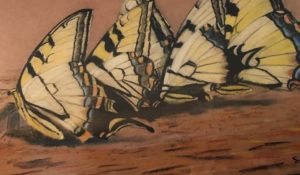
 Collards – by Margie Lewin
Collards – by Margie Lewin
Few culinary traditions run as deep as collards in North Carolina. This leafy green claims one of the longest growing seasons of any in North Carolina’s crops, and is oftentimes all that remains in home gardens and farms come January. On New Year’s Day, tables are filled with foods that symbolize luck and money: black-eyed peas, cornbread, ham and collards, the last of which resemble dollar bills and are believed to invite prosperity. Just like the New Year, collards return again and again to nourish and delight, bringing with them hope and a sense of State pride.
In downtown Ayden, N.C., there is even a Collard Festival parade that includes live music, art shows, food trucks and more. this event is 50 years old.
Lebanon – by Richard Smalto
When I was in the army, I belonged to the 48th armored infantry an outfit stationed in Europe that lost its colors in Korea because it ran. Colors are critical to the success of an army. They mark the location of the commander and serve as a rallying point for the troops. In the chaos of battle the ability to maintain a formation is critical to the army’s success. Because of the use of modern weapons and a change in tactics, colors are no longer carried into battle. However, in the past an elite corps of soldiers protected the colors and it was considered a great feat of arms to capture them.
As a result of this tradition, we watched with a great deal of curiosity and a certain degree of trepidation as each company came to full strength while the remainder of the battalion was put into a state of readiness and complete mobilization. Reorganized and ready one evening. the German girls we were drinking beer with told us not to go to bed that night. That night at two o’clock in the morning we were awakened and mustered to be deployed we knew not where. Loaded onto large troop transport trucks, we moved to an airfield staging area where we waited to be told what our mission was. We drank coffee as airplane engines came to life and non-commissioned officers scurried about. Engines roaring, hearts pounding, the order came to send us back.
Later that day, in the barracks, we learned that Eisenhower decided to give us a chance to recover our colors by sending us into Lebanon to keep the peace. Before the order could be carried out, he changed his mind and told the generals to send in the marines. He said because he thought the 48th would muck it up again.
Somethin’ Fishy: A Fish Tale – by Frank Howes
Once upon a time there was a group of men fishing for herring in a branch that ran into Contentnea Creek in eastern North Carolina. This was in the mid-sixties when the herring and shad were still thick in the rivers and streams when they ran in early April. On this particular occasion, the men were fishing at night, and while they waited for their nets to fill, they told tales around a campfire.
Among those around the campfire was a young man named Eddie and a wizened old man named Mr. Tom.
Eddie was a classic Southern good-ol’ boy and a former high school football star. He was competitive to a fault, and sometimes given to bragging.
Mr. Tom was a laconic old tobacco farmer who was fond of a good joke.
This evening, the conversation, naturally enough, turned to fish stories: who had caught the biggest fish, what was the best fish bait, and so forth. Many people told their story, but after each one, Eddie told a story about a bigger fish. People around the fire were obviously getting impatient with Eddie’s one-upmanship.
Finally, at just the right moment, Mr. Tom started talking. He told a story about a bass he pursued in 1934. “I was a’ter this bass one time in ol’ man Corbett’s pond. I seen him jump once or twice. He was huge, but I could never catch him. Hooked him a couple o’ times, but he got away every time. I was bound and determined to catch that fish, so I kept working at it.
“But that was a smart fish. He never bit on the same bait twice. I started out using worms. Then I used crickets, and later I tried grubs from a wasp nest. Each time I hooked him he got wiser. Like I said, that was a smart fish.”
Determined to outdo Mr. Tom, Eddie said “Yeah, I’ve caught some big bass, but I like artificial lures, especially rubber worms. One time I caught an 11-pound bass on a rubber worm. Man, did he put up a fight.” He paused a moment, then said, “Mr. Tom, did you ever catch that fish.”
“Yeah, I finally caught him. I outsmarted him.”
“What’d you catch him on Mr. Tom?”
Straight faced, without the slightest gleam in his eye, Mr. Tom said, “Castor oil.”
“Castor oil‽ How’d you catch a fish with castor oil‽”
“Well, I found out where that fish was a-layin’ up. I started feedin’ him regular one day. I fed him all the baits I’d used – worms, crickets, grubs, all his favorite foods. And then I used the castor oil, and I caught him!”
“I still don’t get it, Mr. Tom. How’d you catch him with castor oil?”
“Well, I soaked some bait in castor oil, and I fed it to him. I fed him ‘til he couldn’t eat no more, and that’s how I caught him.”
“What,” said Eddie, “I still don’t understand how that helped you catch that fish.”
“Well, that fish was so full, he was about to bust open, and when he crawled up on the bank to take a crap, I just reached down and picked him up.
“Man,” Mr. Tom continued, “that was a whopper! It might have been a mite smaller than your eleven-pound whopper, but that was a big ‘un!”
It’s Never too late…

Olive – The Cat with Seven Lives – by Pat Simpson
Recently my daughter Diana took her two boys, Charlie & Johnnie on a trip to Maine, specifically to Long Cove Artist Cottage, a rustic little self-contained Maine cottage on Deer Isle, located about 20 miles out in Penobscot Bays – a perfect retreat: everything they would need in one location – walking, swimming, and boating.
The boys love animals, and when they met Olive the cat, it was love at first sight. Olive was very friendly, but her patchy fur seemed to indicate she was still on the mend from an injury. Her owner & host, Judith, said she was taken by a Bald Eagle but somehow got away and survived the attack,  crawled home, and managed to get patched back together.
crawled home, and managed to get patched back together.
“Olive was alone and covered in tree sap and very sick when I found her,” Judith explained. “After a lot of baths and medication, she was finally well enough to move back in.”
“Wow,” said Johnnie, “I’m glad she’s alright.”
“So am I,” said Charlie. “I’ll bet she has nightmares1”
Olive, now on the bed where they had placed her, looked up as if she wanted to talk. As you know, cats can’t talk. But I’ll bet you didn’t know they could think…

“You don’t know the half of it,” thought Olive. “Not only can I think, but I do have nightmares…let me tell you why…I was minding my own business – as cats always do – when ‘Bam!’ something hit me on my back. It really hurt! And I immediately felt myself being lifted from the ground. Something was pinching my back and I was getting higher and higher…so high that I thought I was looking down from Heaven.
“That’s when I lost the first of my nine lives.
“Suddenly, whatever or whoever it was, let me go. That’s when I fell from the sky. And that’s when I lost my second life.
“It wasn’t until much later (as my mom Judith explained to me) that I learned eagles drop their prey to incapacitate them. They will use their strong talons to grab them and throw them off a high cliff. After they drop dead from free-fall, the eagle will devour them.
“All I can say is that the next thing I knew, I awoke in the forest the following morning. I was surrounded by dampness, mud, and an overwhelming sense of isolation. My body bore the marks of the harrowing experience, with bruises on my neck, shoulder, and ankle. My right eye was swollen shut and I felt a wave of dizziness wash over me. I came to the grim realization that I had survived a great fall through the forest. Overhead, I could hear the cry of an eagle but the dense canopy of trees obscured me from its view.
“What now?” I thought. “But I realized I had no choice. I had to confront the daunting challenge of surviving alone in the treacherous cold forests of Maine – and I would have to use every survival skill as well.
“Aware that I couldn’t stay there forever, I decided to venture into the forest. I carefully treaded forward, one step at a time, as a precautionary measure to avoid stepping on hidden snakes or insects. I repeated this process – stepping and listening – repeating the cycle as I forged my way through the treacherous terrain.
“I had no food, and when thirst struck, I resorted to licking water droplets from tree leaves. Determined to find civilization and home, I followed a small creek, hoping it would lead me to a larger river and eventually to help. Days without sustenance took their toll. I succumbed to hallucinations. With sheer determination I somehow managed to persevere. However, I heard a voice that seemed too real to be a mere figment of my imagination. It was Judith! She emerged from the forest, took me home and provided me with food and tended to my injuries.
a larger river and eventually to help. Days without sustenance took their toll. I succumbed to hallucinations. With sheer determination I somehow managed to persevere. However, I heard a voice that seemed too real to be a mere figment of my imagination. It was Judith! She emerged from the forest, took me home and provided me with food and tended to my injuries.
“It was Judith who gave me healing. It was Judith who gave me the care I desperately needed.
“Judith, I am but a cat; but I still have seven lives and I’ll be your friend forever!”
P.S. It wasn’t until later that I learned that Judith could have protected me with a “raptor shield”. You know – Protects against raptors. birds of prey: hawks, owls, eagles – like the one that almost got me. You can also get something like a spike vest or a coyote vest. What eagle in its right mind would want to attack cute little me? It would get a mouthful of spikes!”
Our First Wedding Anniversary: A Note of Thanks from Pat and June Cheek Simpson
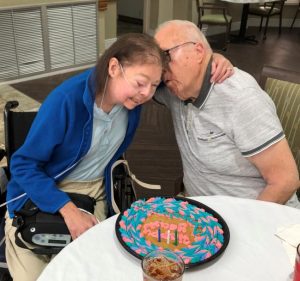
June and I just want everyone to know how grateful and thankful we were for Food and Dietary Director Charlie Banks (C.B.) and his staff’s fabulous treatment of us on Sunday evening, May 21, 2023. Just a couple of days before that I had mentioned in passing to C.B. that Sunday marked our first wedding anniversary. As you may know, June Cheek and I were married right here in the dining room a year ago. We will never forget C.B.’s wonderful food and service at our wedding reception that day.
Fast forward one year later to Sunday evening – food server Mary Saseen had asked us at lunch-time to be at a certain dining room table at 3:30 pm. We knew that something was up – so we indeed arrived on time. Lo and behold, Mary, assisted by Imani Kelly and Jamaul Bible, brought forward a wonderful round wedding anniversary cake with three candles. She got the crowd to say “Happy Anniversary” as June blew out the candles. It was a wonderful cake (and wonderful prime rib) and we had a wonderful time!
I pray for C.B. and his staff every day, asking God to grant them the gifts of “helps”, the gift of patience, and the gift of love. God granted all three prayers last Sunday night. June and I would like to thank them from the bottom of our hearts. May they all have one blessed day after another!
Resident Ramblings
Disclaimer: The information contained in this newsletter represents the views and opinions of the original creators of such information and does not necessarily represent the views or opinions of Independence Village nor does it constitute an endorsement by Independence Village or its affiliates of such information.
Being Authentic – by Margie Lewin
Being authentic is showing  your true personality and character and showing the world who you really are.
your true personality and character and showing the world who you really are.
Here are some thoughtful tips:
- Know your values
- Stop doing things you don’t want to do
- Do what you want to do
- Keep an open mind
- Trust your intuition
- Be self-aware
- Practice boldness
- Openly share your opinion
- Avoid perfectionism
Lessons from Life – by Richard Smalto
I was a bit of an idealist when I was a young man. My father, who worked hard most of his adult life, was a good provider and a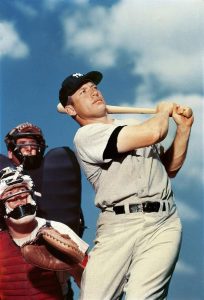 practical person. He had very little patience for what he thought were harebrained intellectual utopian ideas we were promoting at the dinner table; a knowledge we obtained from colleges we attended paid for by him.
practical person. He had very little patience for what he thought were harebrained intellectual utopian ideas we were promoting at the dinner table; a knowledge we obtained from colleges we attended paid for by him.
“The world doesn’t owe you a living,” he would say to me when I complained about my inability to find a job because of lack of experience. “Don’t worry about the rate of unemployment,” he would say to my bother. “There will always be five percent of the population that doesn’t want to work.” (which was the rate of unemployment at that time)
Trying as hard as I could, still unable to find work, wallowing in an orgy of self-pity, I enlisted in the army because I wanted to travel and see the world. When I was in the army I was exposed to and read the book The Fountainhead. It changed my life forever.
Contrast my father’s mild-mannered approach to my self-indulgence to the early life of Mickey Mantle. Mickey Mantle was a major league baseball player who played hurt throughout a tumultuous long-lasting major-league baseball career. In his hotel room alone, after being sent down to the minors because of his inability to hit, he lost confidence and became despondent. Believing his career was over before it began, he reached out to his father, hoping for support. Telling him over the phone he couldn’t play anymore and wanted to go home. His father drove from Commerce, Oklahoma to Kansas City, Missouri. He confronted his son in his hotel room. Mantle said he tried his hardest, lost his confidence wanted to quit and just go home.
“Now you shut up! I don’t wanna hear your whining!” his father bellowed. “I thought I raised a man, not a coward.” Still muttering about the fact “he thought he raised a man not a coward,” he packed his son’s belongings, prepared to take him home.
When the time came to leave, Mantle began to sob and cry; telling his father he would try again.
The harsh rebuke lit a fire under Mantle who was recalled from their farm team by the Yankees. Mantle was a switch-hitter. Though he did not use steroids to help him hit homeruns nevertheless it was said this steroid unaided athlete could hit a ball as far as Ruth lefthanded and or as far as Foxx righthanded. Severely injured early in his career, suffering from osteomyelitis, playing hurt but always playing, Mantle, who was admired by his team mates as a player and as a man because he always played hurt, went on to become one of the most prodigious major league baseball hitters of all times.
Angela and Michael – by Frank Howes
 She was 68. He was 63. They both liked a good glass of wine. “I never thought I’d feel this way again,” said Michael.
She was 68. He was 63. They both liked a good glass of wine. “I never thought I’d feel this way again,” said Michael.
“What do you mean?” Angela said.
Her name is appropriate, thought Michael, she really is an angel. “I think I love you.”
“How can you say that, we’ve only known each other two weeks.”
“Two weeks, two months, two years, what difference does it make? I knew after two days! We’re not kids anymore. We don’t have a lot of years left. I know what I want, and I want to be with you.”
“Be with me? What do you mean by that? We’re already spending most of our days together.”
“I mean I want to marry you. I want to wake up with you by my side every morning.”
“We can’t get married. What would our children say?”
“I know what mine would say, they’d ask, ‘Does she make you happy?’ If I told them how you make me feel they’d say, ‘Go for it. I’m glad you’ve found someone.”
“Mine would say, ‘Don’t do it Mom, he’s just after your money.'”
“I’d sign a prenup if it would reassure them…” Michael continued, “I just told you I think I love you. How do you feel about me?”
“I think… I think…”
“Yes…”
“I think I’m not sure how I feel about you. I know I’m very happy when I’m with you, but marriage? I once swore I’d never get married again. But…”
“But?”
“But, I think maybe I love you too.”
“What are we going to do about it then?”
“I know, why don’t we shack up for a year or so,” she laughed. “See how it goes.”
“You’d do that?”
“Yes.”
“My kids would be scandalized. I raised them in a Christian home. They wouldn’t understand.”
“My kids would have a chance to get to know you. They’d be reassured.”
“Well, I’m willing if you are. You can be my femme fatale. I’ll be your gigolo,” he chuckled.
“Let’s have a toast then, to lecherous, libidinous, lustful, lascivious lovin’.” She laughed again. He loved her laugh.
“You left out delicious, my luscious.”
“To delicious love then.”
“To love.”
He bent and kissed her softly.
The Puzzle Wall – by Pat Simpson
Recently, as I wandered through our activity room, I came upon a wall covered with – you’ll never guess it – jigsaw puzzles. Welcome to Independence Village’s Puzzle Wall!

You may say: So what is a puzzle wall?
Well, as the name implies, rather than wallpaper, the wall is papered with puzzles – yes, jig-saw puzzles. It’s sort of a grand art project – with puzzle themes such as castles, cats, boats, buildings, dogs, dinosaurs, Disney, winter snowmen and summer beaches, to name a few.
Jig saw puzzles have been around since 1767 when British cartographer and engraver John Spilsbury (1739-1769) invented the first jigsaw type puzzle as an educational device to teach geography in 18th-century England. It was not yet called a jigsaw puzzle, however. What he made were called dissected maps. Dissected maps have been a successful educational toy ever since and children today still use them to learn states and countries. Over the past 250 years this educational toy has remained popular among children but also evolved into one of the most popular pastimes for American adults. Jigsaw puzzles have literally been made in all different shapes and sizes and for many different purposes from relieving boredom and stress to being used as an advertising tool.
Dissected pictures followed, covering such subjects as history, alphabets, botany, and zoology. The use of popular pictures began in the 1860s and ’70s, in both Great Britain and the United States. The puzzles became extremely popular in the early 1900s and had a revival in the Great Depression of the 1930s as an inexpensive, reusable amusement. Another revival began after World War II, and jigsaw puzzles have remained a popular entertainment since then.
The “dissected pictures” before me, I later learned, were put together by various resident artists, each of whom signed his or her name onto a wall plaque – hidden among the puzzles – which declared “Welcome to our puzzle wall.” Puzzle-guru Taylor Clodfelter handled the process of getting them on the wall.
I couldn’t help but relate it to Kintsugi, the Japanese art of 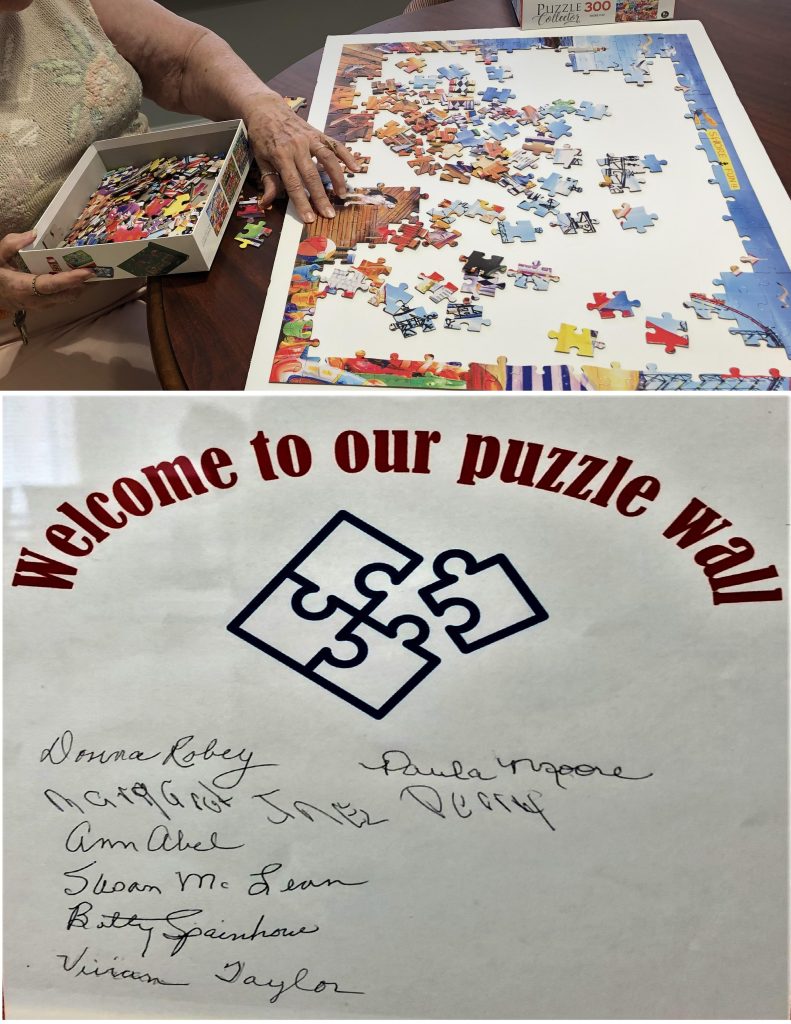 repairing broken pottery by mending the areas of breakage with lacquer dusted or mixed with powdered gold, silver, or platinum. As a philosophy, it treats breakage and repair as part of the history of an object, rather than something to disguise.
repairing broken pottery by mending the areas of breakage with lacquer dusted or mixed with powdered gold, silver, or platinum. As a philosophy, it treats breakage and repair as part of the history of an object, rather than something to disguise.
Kintsugi became closely associated with damaged ceramic vessels used for Japanese tea ceremonies as a more aesthetically pleasing means of repair rather than ugly metal staples. Collectors became so enamored of the new art that some were accused of deliberately smashing valuable pottery so it could be repaired with the gold seams of kintsugi.
 As a philosophy, kintsugi is similar to the Japanese philosophy of wabi -sabi, an embracing of the flawed or imperfect. Japanese aesthetics values marks of wear from the use of an object. This can be seen as a rationale for keeping an object around even after it has broken; it can also be understood as a justification of kintsugi itself, highlighting cracks and repairs as events in the life of an object, rather than allowing its service to end at the time of its damage or breakage.[12] The philosophy of kintsugi can also be seen as a variant of the adage, “Waste not, want not”.
As a philosophy, kintsugi is similar to the Japanese philosophy of wabi -sabi, an embracing of the flawed or imperfect. Japanese aesthetics values marks of wear from the use of an object. This can be seen as a rationale for keeping an object around even after it has broken; it can also be understood as a justification of kintsugi itself, highlighting cracks and repairs as events in the life of an object, rather than allowing its service to end at the time of its damage or breakage.[12] The philosophy of kintsugi can also be seen as a variant of the adage, “Waste not, want not”.
Kintsugi can relate to the Japanese philosophy of mushin (“no mind”), which encompasses the concepts of non-attachment, acceptance of change, and fate as aspects of human life.
Kintsugi is the general concept of highlighting or emphasizing imperfections, visualizing mends and 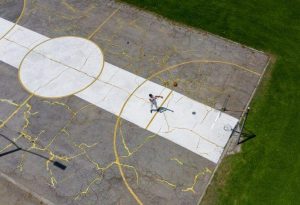 seams as an additive or an area to celebrate or focus on, rather than absen`1`ce or missing pieces. Modern artists and designers experiment with the ancient technique as a means of analyzing the idea of loss and improvement through destruction and repair or rebirth.
seams as an additive or an area to celebrate or focus on, rather than absen`1`ce or missing pieces. Modern artists and designers experiment with the ancient technique as a means of analyzing the idea of loss and improvement through destruction and repair or rebirth.
Kintsugi as an art form and related repair methods have been featured at several exhibitions by contemporary artists and designers who incorporate kintsugi techniques, aesthetics, and philosophies in their work, such as:
Los Angeles artist Victor Solomon, who was inspired by kintsugi practices and philosophies to create “Kintsugi Court”, a fractured public basketball court in South Los Angeles he repaired with gold-dusted resin. The project was finished in 2020 to coincide with the restart of the NBA season, which had been paused due to the Covid-19 pandemic.
